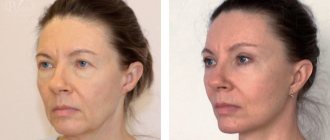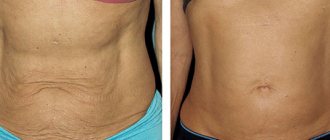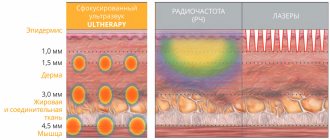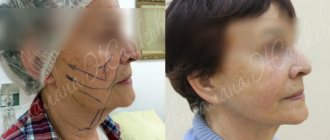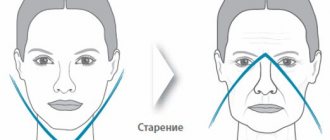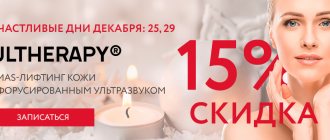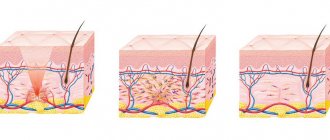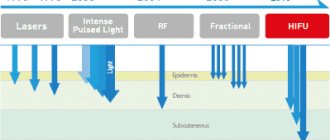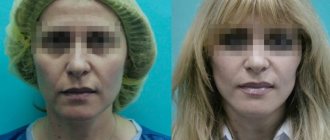Selection of a patient by a cosmetologist
The slogan - to make the hardware SMAS lifting procedure available to everyone who wants it - is not correct, and even harmful.
First of all, these are patients aged 30 to 60 years with the first and second degrees of severity of gravitational ptosis.
We are not talking now about a mandatory condition - the absence of relative and absolute contraindications - this should be observed by default. The main indication for the ultrasonic SMAS lifting procedure is gravitational ptosis and sagging soft tissues, as well as lipolysis of local areas of the face and body.
Let’s imagine a situation where a fairly wealthy patient came to the clinic for a consultation and regularly visits a cosmetologist. She has already done everything to her face: fillers, threads, collagen stimulators, etc. Therefore, in this case it is impossible to say that we will get any clearly expressed results with this patient. There is practically no ptosis.
Thus, a cosmetologist must understand in each specific case what result he expects, as well as whether it will suit his patients.
RF lifting – reviews, effectiveness studies
We can definitely say that RF lifting is effective in increasing skin elasticity by compressing collagen-containing structures and treating cellulite (especially if RF is combined with vibration effects on tissue).
You can also change the contour of your face and neck by destroying excess subcutaneous fat (for example, getting rid of a double chin), as well as reducing bags under your eyes. What you can't do - You can't get rid of wrinkles with this method, don't even try. There are many statements by cosmetologists about increasing the production of one’s own collagen after RF lifting, but no objective methods for assessing the increase in collagen in the skin after RF lifting have been provided in any clinical study.
The only objective method for evaluating any cosmetic procedure aimed at increasing the collagen content of the skin is to take skin samples before and after the treatment. After this, histological sections of the skin are studied under an electron microscope, which makes it possible to clearly say whether an increase in collagen content occurs or does not occur after the exposure.
We specifically searched for published clinical studies on the effectiveness of RF lifting that have such an evidence base. At the moment (January 2016) there is not a single study that has such an objective evidence base, which clearly indicates that statements about stimulating collagen production after RF lifting are unproven.
Two important points -
1) Firstly, the developers of the method talk about an increase in the level of collagen in the skin after RF lifting, which in itself can be verified only after studying electron microscopy data of skin sections before and after exposure. However, the developers do not publish not only electron microscopy images of skin sections, but even data on the quantitative increase in collagen before and after the procedure as a percentage.
By analogy with other methods, where developers usually suppress quantitative data on increasing the level of collagen in the skin (we are talking about plasma lifting, mesothreads) - this should indicate that the level of collagen, if it increases, then this happens either slightly or even at the level statistical error.
2) Secondly, many works have been published proving the effectiveness of RF lifting, but they are all based on completely subjective assessment methods, i.e. on a survey of patients or on a visual analysis of photos before and after RF lifting procedures. Such assessment methods, although subjective, confirm that changes are occurring. But the fact is that these changes occur due to compression of the collagen structures of the skin, and this is not even discussed. But this absolutely cannot be evidence of an increase in collagen content in tissues.
Although, the data from these surveys do not have much clinical value - below we will still present some numbers...
Data from published clinical studies - in 2013, a study was published on the effectiveness and satisfaction of patients after the RF lifting procedure (link to the study). The study involved 45 women with signs of aging skin and (in particular) visible wrinkles on the face. Each woman received 4 weekly RF lifting treatments. Then, after 1 and 6 months, they were surveyed and examined by cosmetologists.
RF lifting - reviews from these women showed that overall satisfaction with the procedure was only about 33.3% one month after the procedure and about 47% after 6 months after the procedure. Partial satisfaction was 53% one month after the procedure and 31% 6 months after the procedure. 8.9% were not at all satisfied with the RF face lifting procedure one month after the procedure and 4.4% after 6 months.
Again, the study does not indicate what exactly the therapy was carried out: bags under the eyes, wrinkles, reduction of the double chin or fatty deposits in the cheek area, and what exactly caused patient satisfaction. For example, can you notice a reduction in wrinkles around the eyes after RF lifting in Fig. 17? But removing the double chin (Fig. 18) and giving elasticity to the skin (Fig. 19) are very noticeable.
RF lifting: before and after photos
CONCLUSIONS: How convincing the evidence base for RF lifting is is up to you to decide. For our part, we have presented all the available arguments to confirm the effectiveness of the method, as well as data that may indicate the dubiousness of some of the declared effects. In addition, in cosmetology there are many absolutely ineffective methods, but which are actively promoted by cosmetologists.
For example, there is a method of facelift using mesothreads. The developers also say that these threads stimulate the production of collagen in the skin. However, studies have shown that there is no trace of any increase in collagen, and the tightening effect is carried out purely mechanically (due to hooks and notches on the threads), as well as due to tissue scarring along the inserted thread.
Facial Thermage - reviews from cosmetologists indicate that this non-invasive facelift procedure is very effective for skin with the first signs of aging. But on the other hand, cosmetologists are an interested party and it is important for them to sell as many services as possible, especially if a clinic buys an expensive device, then no one will refuse to use it, even if it is ineffective. In cases where it is necessary to sell an ineffective method, cosmetologists usually try to impose a combination of methods, one of which will actually have an effect.
For example, to smooth out wrinkles, cosmetologists often recommend a method called plasma lifting, but they do it to their patients mainly only in combination with Botox or with fillers (hyaluronic acid gels), which smooth out wrinkles without any platelet-rich plasma.
Contraindications to the ultrasonic SMAS lifting procedure
Absolute contraindications:
- systemic connective tissue diseases;
- general infectious diseases and skin lesions in the areas of intended treatment;
- severe forms of acne, active systemic or local skin diseases in which the regeneration process is impaired;
- oncological diseases;
- endocrine diseases in the stage of decompensation;
- the presence of metal intradermal implants in the treatment area (except for dental implants);
- decreased or absent threshold of pain (thermal) sensitivity;
- pregnancy, lactation.
Relative contraindications:
- increased body temperature;
- pulmonary heart failure in the stage of decompensation;
- infectious diseases; diabetes mellitus in the stage of decompensation;
- the patient has a pacemaker (consultation with a cardiologist is required);
- neuritis in the area of influence.
INUS device - microneedle radiofrequency system for skin rejuvenation
Lightened, elastic skin without visible wrinkles – this is the result after procedures using the innovative 2022 INUS device. The technology of soft tissue regeneration has the most gentle effect and gives quick, pronounced results. Now you can undergo skin rejuvenation procedures using this micro-needle radiofrequency system at the “Details” cosmetology clinic.
INUS device
Is it painful to do the ultrasonic SMAS lifting procedure?
It is impossible to give an unambiguous answer to this question, because during the procedure, different devices use different levels of energy, different distances between points, and the sensitivity of each patient is different. Application anesthesia is useless, since the effect occurs on the deep layers of the skin.
But sometimes some cosmetologists are guided by the principle “I’ll squeeze harder so that the effect is more noticeable.” Some equipment manufacturers have begun to disable this feature at the hardware level.
Therefore, until you try to give the patient several impulses, you will not know. And the sensitivity of each area of the face will be different.
RF face lifting – what is it?
As we have already said: RF lifting uses radio frequency energy. Technically, radio frequency is a certain number of oscillations (waves) per second of electric and magnetic fields in the radio wave portion of the electromagnetic spectrum. Electromagnetic waves can be generated using voltage and emitted into space in the form of radio waves through an antenna or electrode.
What happens in the skin when exposed to radio frequency energy - according to the developers of the method - RF lifting causes microscopic changes in tissue, followed by remodeling of new collagen, as a result of which subcutaneous structures are improved and tightened. At the same time, during the procedure the texture of the upper layers of the skin is not affected and practically does not change in any way, i.e. You should not expect any smoothing of wrinkles.
An increase in temperature leads to contraction (shrinkage) of collagen-containing tissues. When the maximum operating temperature of 44-50 degrees is reached, even the fibrils inside the collagen fibers themselves are compressed. At this temperature, collagen fibers lose water, denature, shrink and, most importantly, lose their ability to stretch, which leads to increased skin elasticity.
According to the developers of the method and cosmetologists, RF lifting not only compresses collagen fibers, but also stimulates the production of one’s own collagen, which should lead to an increase in the level of collagen content in tissues. However, as you will see further, there is simply no objective evidence that there is also an increase in the amount of collagen.
How RF lifting works: video
What is INUS microcellular radiofrequency energy and why is it effective?
INUS microcellular radiofrequency energy involves four components that successfully complement each other, making the procedure as effective and painless as possible.
- The extreme vacuum line allows the microneedle to be inserted with minimal risk of bleeding and minimal sensitivity for the patient.
- Microneedling systems stimulate collagen formation and regeneration through a scar treatment system.
- Thermal radiofrequency energy is transmitted into the collagen membrane and has a powerful lifting effect.
- The needle electroporation mode increases the absorption and transfer of nutrients.
Another unique feature of the INUS device is the presence of gold nanoparticles in the spray microneedles, which stimulate metabolic processes in cells and accelerate the immune response, thereby increasing the effectiveness of the procedure.
How it works
The device affects the skin of the face, décolleté, and body using thin needles under vacuum. At the initial stage, tissue is captured, fixed and tightened. The microneedles, inserted into the dermal layer under a vacuum grip on the skin, then deliver radiofrequency energy. From microcellular it turns into thermal and stimulates active processes in the dermis.
Initially, collagen fibers contract and the skin tightens and acquires contours. At the next stage, the old collagen is destroyed, and in its place a new one, more elastic and elastic, is regenerated. This is how the skin gradually rejuvenates, small wrinkles disappear, and large ones - along with other defects - become less pronounced.
The INUS device rejuvenates and tightens the skin through microneedles
